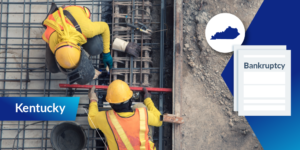
Facing significant debt and a growing number of lawsuits, major Kentucky contractor Charles Deweese Construction (CDC) filed for Chapter 11 bankruptcy on July 1. With millions in debt to more than 440 separate creditors, CDC’s financial future remains uncertain.
CDC’s bankruptcy comes in the midst of some of the largest construction cost increases since the 1970s. The construction industry is still feeling the effects of the pandemic, and many firms have yet to fully recover from the financial setbacks of the last couple of years.
Chapter 11 bankruptcy typically means the company is trying to reorganize to stay afloat. These bankruptcies can be the most complicated — often, the company in question is trying to stay in business, but it can also result in liquidation in the future.
Although bankruptcy filings list significant assets (between $50-100 million), CDC has found itself in a precarious financial situation.
The Kentucky contractor currently holds a 0/100 as its Levelset’s payment score, although there are currently no reviews posted on the company’s profile.
While a number of mechanics liens and late payments have been reported on past projects, the contractor has received 41 mostly positive reviews on Google, earning an overall Google rating of 3.5 stars.
CDC has over 440 unsecured creditors listed in its bankruptcy filing. The top 20 creditors alone are owed more than a combined $24 million, and are mostly suppliers and contractors that CDC has worked with.
The top five creditors owed by CDC and their claims are as follows:
- KL Nexus TN (Florida): $7.1 million
- DeAngelis Diamond Construction (Florida): $4.4 million
- Fortiline Inc. (Georgia): $4.1 million
- Rapid Fueling (Kentucky): $1.5 million
- Kimbro Oil Company (Tennessee) $1 million
Separate from the bankruptcy, CDC is also named in at least two lawsuits. CDC’s surety, United States Fire Insurance Company (USFIC), filed suit against the Kentucky contractor on June 29.
In early June 2022, USFIC received several bond claims against CDC stemming from work on two Tennessee projects totaling roughly $8.7 million.
Court documents note that USFIC was allegedly aware of CDC’s “declining financial health,” and the surety demanded that CDC post collateral of over $8.7 million to “serve as security to protect USFIC from incurring any loss under the bonds.”
When CDC failed to meet USFIC’s demands, the surety filed suit against CDC, and is currently seeking to recover collateral and additional damages to be calculated at trial.
CDC is also being sued by one of its largest creditors, Fortiline Inc. In total, bankruptcy documents reveal CDC owes Fortiline over $4.4 million. However, the lawsuit is specifically over $152,000 in late payments for seven Kentucky projects.
Fortiline supplied pipe, fittings, and other related materials to CDC on credit for a number of projects across Kentucky. The purchase agreement stated that CDC would make payments within 30 days of delivery, but CDC allegedly failed to meet this deadline.
Charles Deweese, owner of CDC, is named in Fortiline’s suit for personally guaranteeing the payment of any debt owed by CDC, as well as any attorney fees. When neither CDC nor Mr. Deweese responded to Fortiline’s demands for payment, the supplier filed suit.
Both USFIC and Fortiline’s lawsuits were filed on June 29, just two days before CDC filed for bankruptcy in the Western District of Kentucky bankruptcy court.
While CDC’s financial struggles appear to have been building for some time (and may have provided further incentive for USFIC and Fortiline to aggressively seek compensation), these lawsuits may have been the final push towards a restructure.
CDC’s bankruptcy filings do report assets of $50-100 million, and note that “funds will be available for distribution to unsecured creditors,” but it’s not yet clear if CDC will be able to fully repay its debts.
With such a significant debt owed to more than 440 different suppliers, GCs, and subcontractors in numerous states, CDC’s bankruptcy could disrupt several projects and send shockwaves down payment chains across the country.
97% of surveyed construction professionals in Levelset’s 2021 Construction Cash Flow & Payment Report reported experiencing stress due to cash flow and payment-related issues — and bankruptcies can represent significant risks to a contractor’s financial stability.
While prequalification can go a long way towards protecting a contractor’s interests, sometimes a GC or sub’s bankruptcy can come as an unwelcome surprise. For contractors who are not able to secure their debt, a bankruptcy can result in huge losses that are not recoverable if the unsecured debt is discharged. However, mechanics liens can allow contractors to secure debt, even through certain cases of bankruptcy.